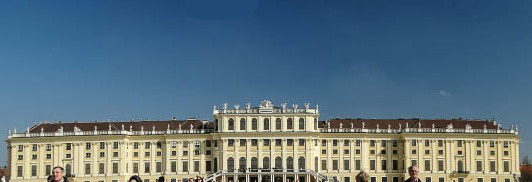
by Mary Ann Olson
The beauty of Vienna, Austria is heard in the music at concert halls, the opera, churches and festivals and seen in the architecture, fashion, museums, art exhibitions, state outdoor parks, and markets. The Viennese residents enjoy a relaxing, congenial good life.
Austria’s capital, Vienna moves at a slower more relaxed pace. Vienna embraces both the Imperial and Contemporary ideals. Vienna is the “City of Music” and “Paris of the East”. The music and beauty of the city are unlike any other city in Europe.
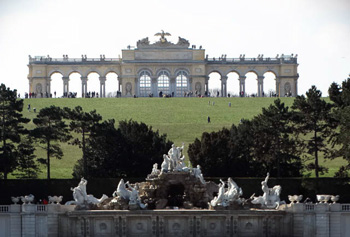 The Ringstrasse or “The Ring Road” is a 3-mile long loop with a grand walking boulevard. The major Ringstrasse, a pedestrian-friendly historic center, has been designated a UNESCO World Heritage Site. Cafes and restaurants line the cobblestone side streets. The culinary scene cannot be overlooked. Located in the Hotel Sacher and the adjoining Cafe, a visitor cannot miss the infamous Sacher-Torte. Cafes abound throughout the avenues with bakery, meal tortes and beverages filled with visitors and Viennese people socializing. Patrons linger and enjoy an outdoor experience of a favorite pastime of people watching. Demel is the ultimate Chocolate shop filled with chocolate lover’s dreams. The Ringstrasse, is the main avenue for prestigious hotels including the Imperial Hotel. The Imperial Palace, Natural History Museum, Kunsthistorisches Museum, Vienna State Opera and the Parliament are located on the Ring. In the town square is St. Stephen’s Cathedral, a Gothic structure built in the 12th century. The Hofburg Imperial Palace, the center of the Habsburg Empire and other attractions are nearby. A morning church service mesmerizes the congregation with the famous Vienna Boys Choir, voices perfectly blended as if listening to an angelic choir.
The Ringstrasse or “The Ring Road” is a 3-mile long loop with a grand walking boulevard. The major Ringstrasse, a pedestrian-friendly historic center, has been designated a UNESCO World Heritage Site. Cafes and restaurants line the cobblestone side streets. The culinary scene cannot be overlooked. Located in the Hotel Sacher and the adjoining Cafe, a visitor cannot miss the infamous Sacher-Torte. Cafes abound throughout the avenues with bakery, meal tortes and beverages filled with visitors and Viennese people socializing. Patrons linger and enjoy an outdoor experience of a favorite pastime of people watching. Demel is the ultimate Chocolate shop filled with chocolate lover’s dreams. The Ringstrasse, is the main avenue for prestigious hotels including the Imperial Hotel. The Imperial Palace, Natural History Museum, Kunsthistorisches Museum, Vienna State Opera and the Parliament are located on the Ring. In the town square is St. Stephen’s Cathedral, a Gothic structure built in the 12th century. The Hofburg Imperial Palace, the center of the Habsburg Empire and other attractions are nearby. A morning church service mesmerizes the congregation with the famous Vienna Boys Choir, voices perfectly blended as if listening to an angelic choir.
Emperor Franz Joseph I ruled the Austro-Hungarian monarchy for 68 years. The year, 2016 marks the 100th anniversary of the Emperor’s death. Franz Joseph was the longest-reigning emperor of Austria. Franz Joseph, one son of Maria Theresa’s sixteen children, married Empress Elizabeth, best known as “Sissy”. She was extremely beautiful with long flowing dark hair beyond her knees which took her attendants two hours each day to brush and style. She was exercising and dieting continuously to maintain her 20-inch waist and was recognized as a true beauty by the Austrian people. Franz Joseph was born at Schonbrunn Palace and died there in 1916 at the age of 86. The property today is preserved as a museum founded by the Austrian Republic. The Palace has been used for important events such as the meeting in 1961 between President John F. Kennedy and Soviet Premier Nikita Khrushchev.
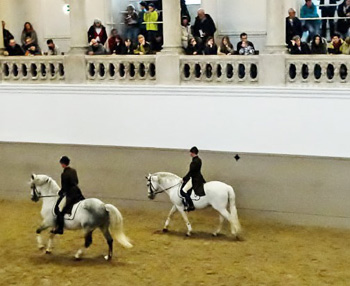 The Schonbrunn Palace, a 1,441-room Baroque palace is one of the most important architectural, cultural and historical monuments in the country. The history of the palace and gardens spans a period of over 300 years of successive Habsburg monarchs. This palace was the former Imperial summer residence. In 1569, the Holy Emperor Maximilian ll purchased the land. It served as a hunting ground and fishing pond. The name Schonbrunn means ‘beautiful spring’ which dates to the artesian well which provided water for the court. From 1638-1643, a palace was added and in 1642, the first mention of Schonbrunn appeared. In its present form today, the place was remodeled in 1740-50’s during the reign of empress Maria Theresa who was given the estate as a wedding gift. Franz l redecorated the palace exterior in neoclassical style which exists today. Forty rooms are opened to the public with frescoes adorning every room, gold gilding on the ceiling and walls and the exquisite décor throughout the palace.
The Schonbrunn Palace, a 1,441-room Baroque palace is one of the most important architectural, cultural and historical monuments in the country. The history of the palace and gardens spans a period of over 300 years of successive Habsburg monarchs. This palace was the former Imperial summer residence. In 1569, the Holy Emperor Maximilian ll purchased the land. It served as a hunting ground and fishing pond. The name Schonbrunn means ‘beautiful spring’ which dates to the artesian well which provided water for the court. From 1638-1643, a palace was added and in 1642, the first mention of Schonbrunn appeared. In its present form today, the place was remodeled in 1740-50’s during the reign of empress Maria Theresa who was given the estate as a wedding gift. Franz l redecorated the palace exterior in neoclassical style which exists today. Forty rooms are opened to the public with frescoes adorning every room, gold gilding on the ceiling and walls and the exquisite décor throughout the palace.
Within the Schonbrunn Palace is the Imperial Palace. Here 20 rooms of the Baroque Period Style are open to the public covering eight sides. The Imperial Palace houses the Emperor’s Crown, scepter, cross and garments worn over the ages. Religious artifacts and precious stones are seen throughout the exhibit rooms. Large and small works of art adorn the walls.
 Located behind the Palace are the Schoenbrunn Gardens. These acres contain a sculpted garden, orangery, maze, long trellised walkways and quiet seating areas. Various movies and major concerts have been filmed on location. Along the Great Parterre are 32 cultures represented by deities and virtues. At the top of the 200-foot hill, is the Gloriette structure. Destroyed in WWW ll, it was restored in 1995. Today it houses an observation deck and café. In front, is the Roman Ruin which consists of a rectangular pool enclosed by an arch with lateral walls. A figural sculpture symbolizes the rivers Vltava and the Elbe.
Located behind the Palace are the Schoenbrunn Gardens. These acres contain a sculpted garden, orangery, maze, long trellised walkways and quiet seating areas. Various movies and major concerts have been filmed on location. Along the Great Parterre are 32 cultures represented by deities and virtues. At the top of the 200-foot hill, is the Gloriette structure. Destroyed in WWW ll, it was restored in 1995. Today it houses an observation deck and café. In front, is the Roman Ruin which consists of a rectangular pool enclosed by an arch with lateral walls. A figural sculpture symbolizes the rivers Vltava and the Elbe.
Hasburg Palace is where the family resided during the remainder of the year. This palace is as ornate as all the other palaces.
The Spanish Riding School with Lipizzaner Stallions demonstrated a morning training session in the Emperor’s Baroque riding hall. Their noble gate and strong breeding, the horses are always born black, fade to gray, and turn a distinctive white as adults. The horses pranced to classical music while above huge, lavish chandeliers hung. A seat in the front row overlooking the stallions was magnificent. The horses begin training at 3-5 years. The riders begin training at 16-18 years old and complete their training in 15 years. A café connected to the riding school area provided selections of coffees, apple strudel and other baked delicacies.
 Belvedere Palace is two palaces, the Upper and the Lower. Here is where the Belvedere Museum is housed. It contains art from the 19thand 20th Century Austrian artists. Located inside the Osterreichische Gallery is a replica of the famous “The Kiss” which is a self-portrait of Gustoff Klimt. Adorned in the Baroque style, the property has decorated tiered fountains, sculptures, wrought iron gates and an expansive decorative garden.
Belvedere Palace is two palaces, the Upper and the Lower. Here is where the Belvedere Museum is housed. It contains art from the 19thand 20th Century Austrian artists. Located inside the Osterreichische Gallery is a replica of the famous “The Kiss” which is a self-portrait of Gustoff Klimt. Adorned in the Baroque style, the property has decorated tiered fountains, sculptures, wrought iron gates and an expansive decorative garden.
Maria Theresa’s center statue overlooks the Albertina Art Museum. It contains multi-national works of artists from Austria, Germany, Italy, Netherlands, and Spain.
St. Stephen’s stands in the center square towering over the city. It is a Gothic Cathedral in an ornate Gothic/Baroque style. The church is extremely ornate with a high altar, pulpit, organ and massive organ pipes. Frescoes and sculptures cover every crevice of the cathedral. Side altars depicting saints surround the nave. Towering spires rising above the city of Vienna, it is a masterpiece of architecture and a sightseeing symbol of Vienna. In front, is a large gathering square with side streets of shops, street musicians and cafes in every direction.
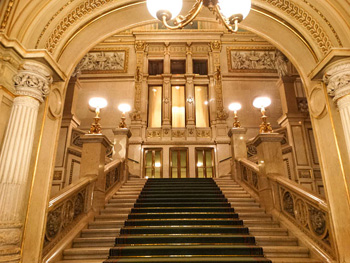 The Vienna State Opera is the World’s Greatest Opera House. Entering the front doors is a grand staircase of marble, chandeliered lobby, shimmering gold statues and lush carpeting. New Operas are presented nightly. The opera house, built in the 1860’s by Emperor Franz Joseph was inaugurated in 1869 with a performance of Mozart’s ‘Don Juan’. In 1945, the opera house was bombed. All that remained was the main façade, the grand staircase, the main lobby, attached veranda and the Tea Salon. In 1955, the opera reopened with the performance of Beethoven’s ‘Fidelio’. This opera house is the pride of Vienna. Concerts and classical music abound in the city. I was fortunate to have a private, early morning tour with a small group. The interior of the opera is opulent in size, seating 2200 attendees on the floor, selective boxes, and dignitary balcony seating. Standing by the orchestra pit one could imagine conducting the orchestra to a famous Mozart, Beethoven or Strauss performance. The stage, the size of the opera house itself was in the process of preparing for the evening performance. Although the stage is huge, costumes and scenery are stored in a nearby building until morning transfer to the stage. Work with the stage crew continues twenty-four hours a day. The luxurious intermission rooms for dignitaries were immense with gilded and architectural ceilings with frescoes. Mirrors adorned the walls for ladies to admire their luxurious gowns. Every box also had a small intermission area with beverages. Walking throughout the streets of Vienna, music can be heard from concert venues, churches, shopping areas and festivals held during the season.
The Vienna State Opera is the World’s Greatest Opera House. Entering the front doors is a grand staircase of marble, chandeliered lobby, shimmering gold statues and lush carpeting. New Operas are presented nightly. The opera house, built in the 1860’s by Emperor Franz Joseph was inaugurated in 1869 with a performance of Mozart’s ‘Don Juan’. In 1945, the opera house was bombed. All that remained was the main façade, the grand staircase, the main lobby, attached veranda and the Tea Salon. In 1955, the opera reopened with the performance of Beethoven’s ‘Fidelio’. This opera house is the pride of Vienna. Concerts and classical music abound in the city. I was fortunate to have a private, early morning tour with a small group. The interior of the opera is opulent in size, seating 2200 attendees on the floor, selective boxes, and dignitary balcony seating. Standing by the orchestra pit one could imagine conducting the orchestra to a famous Mozart, Beethoven or Strauss performance. The stage, the size of the opera house itself was in the process of preparing for the evening performance. Although the stage is huge, costumes and scenery are stored in a nearby building until morning transfer to the stage. Work with the stage crew continues twenty-four hours a day. The luxurious intermission rooms for dignitaries were immense with gilded and architectural ceilings with frescoes. Mirrors adorned the walls for ladies to admire their luxurious gowns. Every box also had a small intermission area with beverages. Walking throughout the streets of Vienna, music can be heard from concert venues, churches, shopping areas and festivals held during the season.
 The Kursalon is an opulent Renaissance style icon concert hall. The stirring music of Johann Strauss and Wolfgang Mozart is performed in Lanner Hall for visitors to celebrate Viennese music with vocalists, ballet and concert orchestra. Outside, in Vienna’s City Park, is one of the most photographed monuments in Vienna, The gold statue of “The Waltz King”…Johann Strauss. In 1921, as the ‘Blue Danube Waltz’ played, Edmund Hellmer’s statue was unveiled. Strauss’s waltzes kept the 300 ballroom floors around Vienna spinning with Viennese Waltzes during the 19th Century. Today, Balls continue to be held in the ballrooms and palaces. Dance lessons are a requirement to properly dance the Viennese waltz. During the ‘season’, couples elegantly dress in ball gowns and tuxedos, to participate in the Grand Waltz Balls or the Debutante Balls. During the summer, evening music performances reminisce the music of Strauss, Schubert, Beethoven, Haydn, Liszt and Mozart.
The Kursalon is an opulent Renaissance style icon concert hall. The stirring music of Johann Strauss and Wolfgang Mozart is performed in Lanner Hall for visitors to celebrate Viennese music with vocalists, ballet and concert orchestra. Outside, in Vienna’s City Park, is one of the most photographed monuments in Vienna, The gold statue of “The Waltz King”…Johann Strauss. In 1921, as the ‘Blue Danube Waltz’ played, Edmund Hellmer’s statue was unveiled. Strauss’s waltzes kept the 300 ballroom floors around Vienna spinning with Viennese Waltzes during the 19th Century. Today, Balls continue to be held in the ballrooms and palaces. Dance lessons are a requirement to properly dance the Viennese waltz. During the ‘season’, couples elegantly dress in ball gowns and tuxedos, to participate in the Grand Waltz Balls or the Debutante Balls. During the summer, evening music performances reminisce the music of Strauss, Schubert, Beethoven, Haydn, Liszt and Mozart.
In front of the Parliament Building is the Athena Statue. Within the Parliament are committee rooms, libraries, dining rooms, bars and a gymnasium. The Town Hall in front is where the well-known Christmas Market is held yearly.
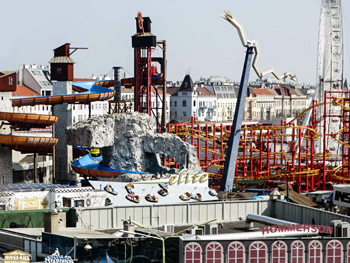 The Hausdermisik, the Music House, located in the old city center has an interactive music keyboard stairway and other musical hands-on experiences. The five upper floors feature all the composers who lived, composed and performed in the Vienna Concert Halls and Opera House.
The Hausdermisik, the Music House, located in the old city center has an interactive music keyboard stairway and other musical hands-on experiences. The five upper floors feature all the composers who lived, composed and performed in the Vienna Concert Halls and Opera House.
Vienna has many green spaces. The Prater was designed as a large space for the Viennese people to enjoy the outdoors. Today it is an amusement park with enclosed cabins which rotate like a ferris wheel. Fabulous pictures of the city can be taken on this slowly moving ride.
On nearly every corner is a pub or café with locals and visitors. During the day and evening, they linger and enjoy conversations and an evening of drinking bier. Nearby, clustered around the towns, are the wine gardens. A visit to Heiligenstadt is the Beethovenhaus Wine Garden where Beethoven lived and began working on his Ninth Symphony.
 The Naschmarkt, Vienna’s Old World Market of 120 stalls immerses you in the flavors and colors of Vienna. Here you will find vendors selling fruit, vegetables, meat, fish, olives, bread, oils, wine and handmade products. Small indoor and outdoor restaurants line the corridors including a beer garden. This is an International market of food and spices from throughout the world. Chefs buy produce from the market to prepare meals in upscale city restaurants. Chatting with the vendors and sampling sweet crepes and Austrian cheeses from alpine dairies makes for an enjoyable, delectable afternoon.
The Naschmarkt, Vienna’s Old World Market of 120 stalls immerses you in the flavors and colors of Vienna. Here you will find vendors selling fruit, vegetables, meat, fish, olives, bread, oils, wine and handmade products. Small indoor and outdoor restaurants line the corridors including a beer garden. This is an International market of food and spices from throughout the world. Chefs buy produce from the market to prepare meals in upscale city restaurants. Chatting with the vendors and sampling sweet crepes and Austrian cheeses from alpine dairies makes for an enjoyable, delectable afternoon.
Charles’ Church was built in the early 1770’s. Art, teaching, and music are represented among the hundreds of frescoes, main altar, side altars and organ pipes. Musical Masterpieces are performed here frequently.
If You Go:
♦ Specific advice for visiting Vienna is to contact the Vienna Chamber of Commerce. Centrally located you can receive advice from highly qualified, multi-lingual individuals. The Commerce provides brochures on all cultural sights, performances, museums, churches and any other interests you may have. Address: Albertinaplatz, 1010 Wien, Austria Phone:+43 1 24555
♦ Purchase a 48 or 72 hour Vienna Tourist Pass. The pass allows for unlimited use of trams and the underground for transportation. The pass also provides for tourist site discounts.
♦ Explore the city while relaxing in a horse drawn carriage.
♦ The Hop-On, Hop-Off Bus Tour is a double-decker bus with panoramic views.
♦ See Vienna by bike, small tours, private tours or by boat on the Danube.
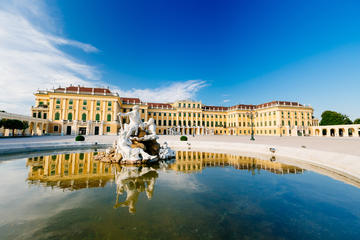
Vienna Pass Including Hop-On Hop-Off Bus Ticket
About the author:
Mary Ann Olson is a published journalist, travel writer and musician. She is a member of the Professional Writers’ Alliance and the International Travel Writer and Photographers Association. Mary Ann provides great insight into the culture, music and arts in the countries visited. Wine and Food are a passion and a focus of her travel writing. She shares her travels at I Write About Travel.com.
All photos are by Mary Ann Olson:
Schonbrunn Palace
Schonbrunn Gardens
Lipizzaner Stallions
Belvedere Palace
St. Stephen’s Cathedral
Vienna State Opera
Johann Strauss
Prater
Naschmarkt



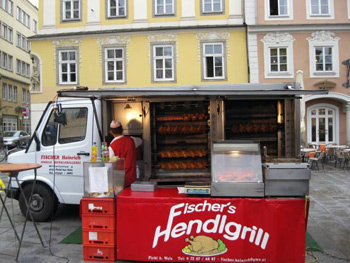
 Some of my personal favorite ethnic eats are in Austria. In Wels a small town in the Northwestern section of the country there is a local market which is very similar to the Westside Market in Cleveland, Ohio. A new building was recently constructed to house the vendors. On the outside of the market vendors sell various fresh fruits and vegetables etc. Nothing there is prepackaged. Inside the building the vendors provide various types of fresh food including meat, poultry, eggs, cheese and even schnapps (whiskey). My favorite vendor has barbecue roast chicken on a spit and as of late a new item lightly breaded chicken wings which go well with a stein (a traditional German beer tankard) of beer. Priced by the kilogram (2.2 pounds) US $3.00-$5.00.
Some of my personal favorite ethnic eats are in Austria. In Wels a small town in the Northwestern section of the country there is a local market which is very similar to the Westside Market in Cleveland, Ohio. A new building was recently constructed to house the vendors. On the outside of the market vendors sell various fresh fruits and vegetables etc. Nothing there is prepackaged. Inside the building the vendors provide various types of fresh food including meat, poultry, eggs, cheese and even schnapps (whiskey). My favorite vendor has barbecue roast chicken on a spit and as of late a new item lightly breaded chicken wings which go well with a stein (a traditional German beer tankard) of beer. Priced by the kilogram (2.2 pounds) US $3.00-$5.00.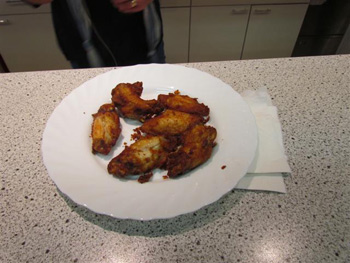 There are other taste treats to learn about and experience. Crossing from Slovenia into Croatia passing through village after village the signs for roast pork (svinjina) and lamb (jagnjetina grilled lamb both roasted on spit) began to appear. The local Gostionas (Restaurants, Bars) were preparing their grills for roasting. As luck would have it, we always seemed to miss many of these establishments. It might have been sheer luck and or just bad timing. We were either too early or too late for lunch or there was not a Gostiona located in the area where we were.
There are other taste treats to learn about and experience. Crossing from Slovenia into Croatia passing through village after village the signs for roast pork (svinjina) and lamb (jagnjetina grilled lamb both roasted on spit) began to appear. The local Gostionas (Restaurants, Bars) were preparing their grills for roasting. As luck would have it, we always seemed to miss many of these establishments. It might have been sheer luck and or just bad timing. We were either too early or too late for lunch or there was not a Gostiona located in the area where we were. Having been in the former Yugoslavia a few times we learned over the years on what to look for when it comes to roast pork and lamb. Normally vendors and restaurateurs post signs advertising their wares along the road. Driving through Split on the Jadranska Magistrala along the coast toward Dubrovnik about lunch time we just could not find an establishment that had roast lamb or pork. Either we missed the signs or there just weren’t any. Finally we stopped at a local restaurant and we were given directions on where to find janjetina. Down the road and up the side of a sparsely covered mountain, we traveled higher and higher on the narrow pebbled road turning this way and that as the road curved back and forth along the side of the mountain, my cousin sitting in the back seat hanging firmly on to the hand strap fixed to the car roof. We drove on and on for over an hour. Finally we found it. The war had taken its toll. It was a bombed out building and on the side of the building a faded wooden sign advertised jagnjetina. My cousin started laughing hysterically!!! Someone was having a good laugh on us. Consequently we did not have roast pork or jagnjetina this day.
Having been in the former Yugoslavia a few times we learned over the years on what to look for when it comes to roast pork and lamb. Normally vendors and restaurateurs post signs advertising their wares along the road. Driving through Split on the Jadranska Magistrala along the coast toward Dubrovnik about lunch time we just could not find an establishment that had roast lamb or pork. Either we missed the signs or there just weren’t any. Finally we stopped at a local restaurant and we were given directions on where to find janjetina. Down the road and up the side of a sparsely covered mountain, we traveled higher and higher on the narrow pebbled road turning this way and that as the road curved back and forth along the side of the mountain, my cousin sitting in the back seat hanging firmly on to the hand strap fixed to the car roof. We drove on and on for over an hour. Finally we found it. The war had taken its toll. It was a bombed out building and on the side of the building a faded wooden sign advertised jagnjetina. My cousin started laughing hysterically!!! Someone was having a good laugh on us. Consequently we did not have roast pork or jagnjetina this day.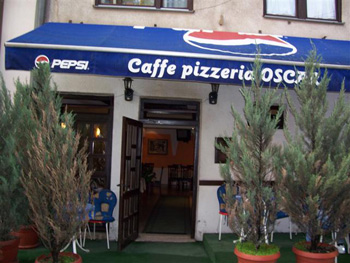 On another occasion we were traveling by bus from Sarajevo to Mostar we stopped in the town of Jablanica to view the local historical sights. We learned from the locals just on the outskirts about one kilometer south of Jablanica was the restaurant Zdrava Voda (Health Water). There on six roasting spits was lamb grilling on an open fire continuously throughout the day enough to quell the hunger for both the tourist traveling between Sarajevo and Mostar and the local population. The price was US $15.00 which included potatoes, salad, and bread. Jablanica is known for this mouth watering delicacy and that there are over 8 restaurants in the vicinity that serve it. www.zdravavoda.co.ba
On another occasion we were traveling by bus from Sarajevo to Mostar we stopped in the town of Jablanica to view the local historical sights. We learned from the locals just on the outskirts about one kilometer south of Jablanica was the restaurant Zdrava Voda (Health Water). There on six roasting spits was lamb grilling on an open fire continuously throughout the day enough to quell the hunger for both the tourist traveling between Sarajevo and Mostar and the local population. The price was US $15.00 which included potatoes, salad, and bread. Jablanica is known for this mouth watering delicacy and that there are over 8 restaurants in the vicinity that serve it. www.zdravavoda.co.ba
 In Sarajevo the restaurant Cevabdzinica Zeljo, on street Kundurdziluk 18, in the Bascarsija seems to be the favorite place for locals to enjoy a “healthy” meal of cevapcici with onions, sour cream and yogurt. Cevapcici is beef minced meat in a roll served with pita bread and priced under US $7.00. Other versions of this delicacy are made with ground lamb, veal, and pork.
In Sarajevo the restaurant Cevabdzinica Zeljo, on street Kundurdziluk 18, in the Bascarsija seems to be the favorite place for locals to enjoy a “healthy” meal of cevapcici with onions, sour cream and yogurt. Cevapcici is beef minced meat in a roll served with pita bread and priced under US $7.00. Other versions of this delicacy are made with ground lamb, veal, and pork.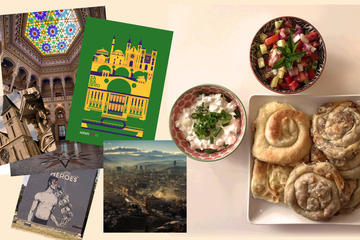
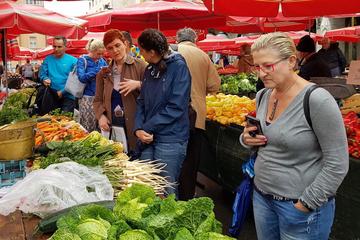
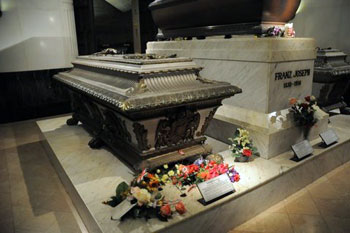
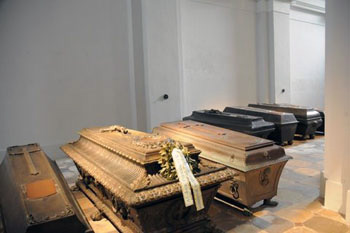 There, in that church crypt, is most of the royalty that led the Holy Roman, and Austro-Hungarian empires. The history of those several hundred years, 1618 to 2011 (the last Habsburg to make it in was laid to rest in July 2011), shaped Europe and the Americas. It wasn’t a well-defined, clearly delineated empire that the Habsburgs governed. At various times they ruled 44 nations, duchies, and a variety of ethnic gatherings; some were part of the Holy Roman Empire, some were not – such was the political jigsaw puzzle of Europe back then.
There, in that church crypt, is most of the royalty that led the Holy Roman, and Austro-Hungarian empires. The history of those several hundred years, 1618 to 2011 (the last Habsburg to make it in was laid to rest in July 2011), shaped Europe and the Americas. It wasn’t a well-defined, clearly delineated empire that the Habsburgs governed. At various times they ruled 44 nations, duchies, and a variety of ethnic gatherings; some were part of the Holy Roman Empire, some were not – such was the political jigsaw puzzle of Europe back then. Anna, in her will, written in 1617, set aside funds to begin building that crypt. Good thing she did – she died a year later. Her husband died the following year. Politics and war put off the crypt building until 1633. Their burials were the beginning of a practice that reached its royal conclusion this year. On July 4, 2011 Otto von Habsburg, also known as Otto of Austria, “former head of the House of Habsburg and Sovereign of the Order of the Golden Fleece (1922–2007) and former Crown Prince (1916–1918) and, by pretence, Emperor-King (from 1922), of Austria-Hungary—or formally, of Austria, Hungary and Bohemia, of Dalmatia, Croatia, Slavonia, Galicia, Lodomeria and Illyria, and of Jerusalem…” (There’s more, but you get the idea.) — died. He was 98. And that should pretty much do it for the House of Habsburg.
Anna, in her will, written in 1617, set aside funds to begin building that crypt. Good thing she did – she died a year later. Her husband died the following year. Politics and war put off the crypt building until 1633. Their burials were the beginning of a practice that reached its royal conclusion this year. On July 4, 2011 Otto von Habsburg, also known as Otto of Austria, “former head of the House of Habsburg and Sovereign of the Order of the Golden Fleece (1922–2007) and former Crown Prince (1916–1918) and, by pretence, Emperor-King (from 1922), of Austria-Hungary—or formally, of Austria, Hungary and Bohemia, of Dalmatia, Croatia, Slavonia, Galicia, Lodomeria and Illyria, and of Jerusalem…” (There’s more, but you get the idea.) — died. He was 98. And that should pretty much do it for the House of Habsburg.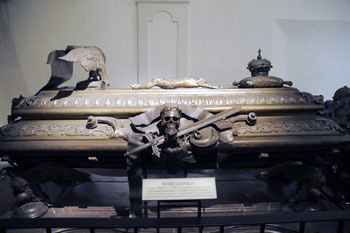 From 1618 on, casket after casket was put in place, making it necessary to expand, creating rooms for more Habsburg royalty. One huge room was designed just to hold the gigantic, highly embellished tomb of Maria Theresia, probably the most famous of all the Habsburgs. The artwork on Maria’s tomb is astonishing. The practice of interring organs in one church, the heart in another, and the body in the crypt of the Capuchin church began with King Ferdinand IV of the Romans in 1654. He left orders that his body was to go to the Capuchins; his heart to Augustinerkirche; and the urn with his viscera to Vienna’s St. Stephens. A few urns remain with the Capuchins. It’s tad ghoulish, to be sure, but a custom – unique to the Habsburgs – that exists to this day. The last three-stages of separation took place July of 2010 for Otto von Habsburg.
From 1618 on, casket after casket was put in place, making it necessary to expand, creating rooms for more Habsburg royalty. One huge room was designed just to hold the gigantic, highly embellished tomb of Maria Theresia, probably the most famous of all the Habsburgs. The artwork on Maria’s tomb is astonishing. The practice of interring organs in one church, the heart in another, and the body in the crypt of the Capuchin church began with King Ferdinand IV of the Romans in 1654. He left orders that his body was to go to the Capuchins; his heart to Augustinerkirche; and the urn with his viscera to Vienna’s St. Stephens. A few urns remain with the Capuchins. It’s tad ghoulish, to be sure, but a custom – unique to the Habsburgs – that exists to this day. The last three-stages of separation took place July of 2010 for Otto von Habsburg.

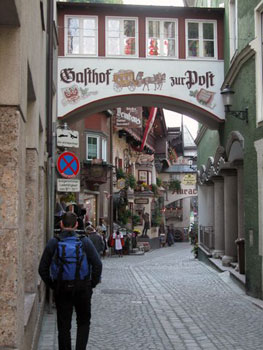 Joe, my husband, and I arrived in Munich, Germany on a sunny afternoon in September. Using the airport mini bus service we arrived in Kundle an hour and a half later. Anna, the Master Carver’s wife, a small, slim lady with sparkling eyes ran down a flight of stairs to greet us. She whisked us to a spacious second floor guest room with a large deck overlooking gardens and a spectacular view of the mountains. We followed Anna as she ran across the garden and up another flight of stairs that led to a door with an impressive eagle carved in relief. Stepping through the door was akin to entering a tree house filled with industrious wood spirits. Sunlight filtered through floor to ceiling windows of a huge workshop, sharp tools sizzled across fragrant pine. Intricate carvings came to life under Herr Binder’s soft spoken direction and shrewd eye.
Joe, my husband, and I arrived in Munich, Germany on a sunny afternoon in September. Using the airport mini bus service we arrived in Kundle an hour and a half later. Anna, the Master Carver’s wife, a small, slim lady with sparkling eyes ran down a flight of stairs to greet us. She whisked us to a spacious second floor guest room with a large deck overlooking gardens and a spectacular view of the mountains. We followed Anna as she ran across the garden and up another flight of stairs that led to a door with an impressive eagle carved in relief. Stepping through the door was akin to entering a tree house filled with industrious wood spirits. Sunlight filtered through floor to ceiling windows of a huge workshop, sharp tools sizzled across fragrant pine. Intricate carvings came to life under Herr Binder’s soft spoken direction and shrewd eye.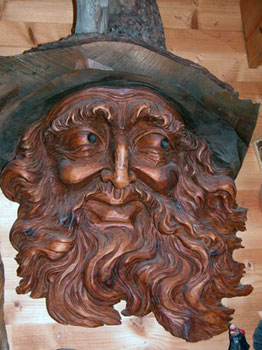 Carving in Kundle was a unique experience, surrounded by beautiful carvings it was impossible not to be inspired. Eagles, wings outstretched, perched near windows as though waiting to take flight. Alpine Ibex, with enormous backward curving horns, seemed ready to leap off craggy, wooden rocks. Larger than life faces with swirling beards, tangled hair and mischievous eyes smiled down from walls as we carved.
Carving in Kundle was a unique experience, surrounded by beautiful carvings it was impossible not to be inspired. Eagles, wings outstretched, perched near windows as though waiting to take flight. Alpine Ibex, with enormous backward curving horns, seemed ready to leap off craggy, wooden rocks. Larger than life faces with swirling beards, tangled hair and mischievous eyes smiled down from walls as we carved.
 Postcards often depict glimpses of destinations quite unrelated to reality. Kundle is the exception. Intricately carved wooden balconies and eves changed pastel colored walls of houses, shops and restaurants into whimsical gingerbread creations. Geraniums, petunias and ferns tumbled in cascades of color from every balcony and window box. The Hanging Gardens of Babylon could not have looked more beautiful. Narrow winding streets led to fountains where children splashed on their way home from school and towns people gathered to eat lunch. Five restaurants served a variety of food, we enjoyed authentic Austrian dishes in a restaurant where massive wood furnishings, beams and doors were heavily decorated with carvings. Family members gathered in large groups for dinner and men in colorful lederhosen stopped for a pint of lager en-route to festival rehearsals. As the atmosphere filled with camaraderie, clinking glasses, bursts of regional songs and laughter, enhanced by wafts from the kitchen of frying Wiener Schnitzel, Goulash and apfelstrudel, we felt we were on stage, part of the cast in a movie extravaganza.
Postcards often depict glimpses of destinations quite unrelated to reality. Kundle is the exception. Intricately carved wooden balconies and eves changed pastel colored walls of houses, shops and restaurants into whimsical gingerbread creations. Geraniums, petunias and ferns tumbled in cascades of color from every balcony and window box. The Hanging Gardens of Babylon could not have looked more beautiful. Narrow winding streets led to fountains where children splashed on their way home from school and towns people gathered to eat lunch. Five restaurants served a variety of food, we enjoyed authentic Austrian dishes in a restaurant where massive wood furnishings, beams and doors were heavily decorated with carvings. Family members gathered in large groups for dinner and men in colorful lederhosen stopped for a pint of lager en-route to festival rehearsals. As the atmosphere filled with camaraderie, clinking glasses, bursts of regional songs and laughter, enhanced by wafts from the kitchen of frying Wiener Schnitzel, Goulash and apfelstrudel, we felt we were on stage, part of the cast in a movie extravaganza.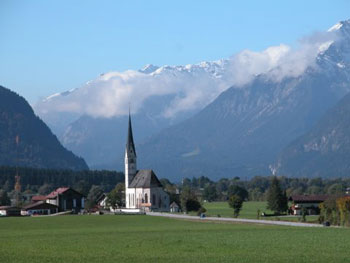 Strolling home one evening after a delicious meal of smoked trout in a mid seventeenth century Pension we heard the clanging of cow bells. A herd of cows came bustling up a side-street heading for their night quarters in a barn attached to a house. At seven o’clock in the evening it was the duty of anyone passing by to stand at the top of the street and encourage the animals not to make a detour through town.
Strolling home one evening after a delicious meal of smoked trout in a mid seventeenth century Pension we heard the clanging of cow bells. A herd of cows came bustling up a side-street heading for their night quarters in a barn attached to a house. At seven o’clock in the evening it was the duty of anyone passing by to stand at the top of the street and encourage the animals not to make a detour through town.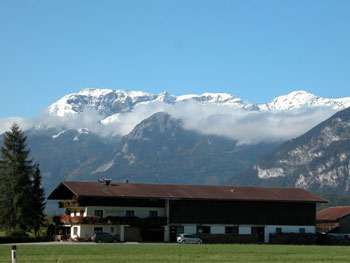 I signed up for three weeks carving instruction, choosing to carve mornings only, leaving time to catch the train to numerous small Tyrolean towns within thirty minutes ride of Kundle. Even the smallest town boasted a castle, large or small, huddled on mountain tops the castles looked down on the inhabitants like benevolent protectors. Rattenburg with a population of 440 is the smallest town in the country. Founded in the 14th century it was built in the shadow of Rat Mountain to protect it from marauders. Following ancient cobblestone streets we stumbled upon a glass blowing demonstration. A cavernous area hewn deep into rock displayed hand blown glass animals, birds, dragons and flowers. Suspended from the cave ceiling lit by soft, revolving colored lights the glass sculptures cast dancing shadows across ancient stone walls. Sparkling Austrian crystal, dazzling rainbows of color, glistened like stalactites in dark corners. This little town, characterized by its medieval ambience is known far and wide as “glass town.”
I signed up for three weeks carving instruction, choosing to carve mornings only, leaving time to catch the train to numerous small Tyrolean towns within thirty minutes ride of Kundle. Even the smallest town boasted a castle, large or small, huddled on mountain tops the castles looked down on the inhabitants like benevolent protectors. Rattenburg with a population of 440 is the smallest town in the country. Founded in the 14th century it was built in the shadow of Rat Mountain to protect it from marauders. Following ancient cobblestone streets we stumbled upon a glass blowing demonstration. A cavernous area hewn deep into rock displayed hand blown glass animals, birds, dragons and flowers. Suspended from the cave ceiling lit by soft, revolving colored lights the glass sculptures cast dancing shadows across ancient stone walls. Sparkling Austrian crystal, dazzling rainbows of color, glistened like stalactites in dark corners. This little town, characterized by its medieval ambience is known far and wide as “glass town.”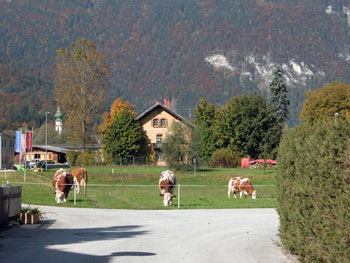 Kufstein, located between South Tyrol in Italy and Bavaria in Germany is known as the “pearl of the Tyrol.” It has about 15,000 inhabitants, the majestic Kufstein Fortress, a massive fortification dating from the mid 12th century rears above the town on a precipitous crag. An interesting feature of the fortress is the “Heroes” organ built in 1931 it was the first open air organ in the world. During summer months concerts are played at noon each day in memory of those who died in the two world wars. In both world wars the Fortress tunnels were used for shelter. Sitting in an out-door café by the beautiful Inn River savoring chocolate cream cake while listening to the soulful organ music float down from the fortress and drift through the flower filled historical district below is a magical experience. The music can be heard eight miles away.
Kufstein, located between South Tyrol in Italy and Bavaria in Germany is known as the “pearl of the Tyrol.” It has about 15,000 inhabitants, the majestic Kufstein Fortress, a massive fortification dating from the mid 12th century rears above the town on a precipitous crag. An interesting feature of the fortress is the “Heroes” organ built in 1931 it was the first open air organ in the world. During summer months concerts are played at noon each day in memory of those who died in the two world wars. In both world wars the Fortress tunnels were used for shelter. Sitting in an out-door café by the beautiful Inn River savoring chocolate cream cake while listening to the soulful organ music float down from the fortress and drift through the flower filled historical district below is a magical experience. The music can be heard eight miles away.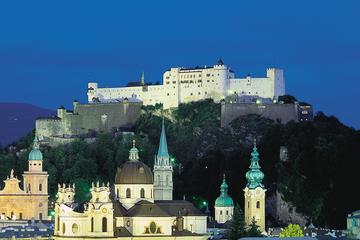
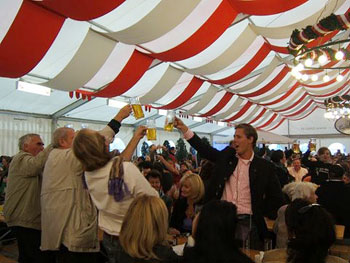
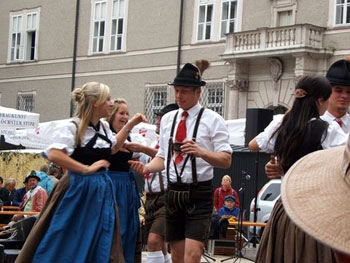 Spinning rides and vendor booths pack the central square. They are selling wooden toys and traditional crafts and that curious gingerbread that seems to be a fixture of the German-speaking festival: heart-shaped with endearments printed in icing, meant to be worn around the neck. There’s music in the streets, and a group has gathered around to watch an old couple who is dancing a slow waltz. I’m surprised to see how many people have arrived wearing the traditional lederhosen and dirndls. As I squeeze my way between hordes of carousing Austrians, I feel as if I have arrived in the wrong city. I hadn’t pictured the town of Mozart’s birth to have such activity.
Spinning rides and vendor booths pack the central square. They are selling wooden toys and traditional crafts and that curious gingerbread that seems to be a fixture of the German-speaking festival: heart-shaped with endearments printed in icing, meant to be worn around the neck. There’s music in the streets, and a group has gathered around to watch an old couple who is dancing a slow waltz. I’m surprised to see how many people have arrived wearing the traditional lederhosen and dirndls. As I squeeze my way between hordes of carousing Austrians, I feel as if I have arrived in the wrong city. I hadn’t pictured the town of Mozart’s birth to have such activity.
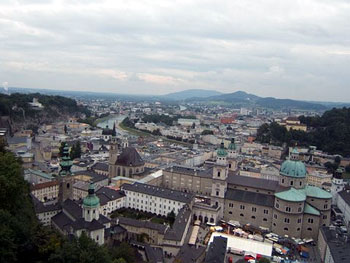 The older gentleman sitting across from me tries to engage me in conversation, so I bust out my best German – in my poor imitation of the Northern German accent I had learned in school. I might as well have been speaking gibberish to the Austrian, so we settle on my native tongue. A pair of women join the stilted English conversation, and I finally learn that September 24th is the Feast of St. Rupert, the patron saint of Salzburg. The festival in town occurs on the weekend each year closest to that date.
The older gentleman sitting across from me tries to engage me in conversation, so I bust out my best German – in my poor imitation of the Northern German accent I had learned in school. I might as well have been speaking gibberish to the Austrian, so we settle on my native tongue. A pair of women join the stilted English conversation, and I finally learn that September 24th is the Feast of St. Rupert, the patron saint of Salzburg. The festival in town occurs on the weekend each year closest to that date. But then the three Austrians start a new game that I can only describe as ‘inebriate the foreigner’. A second beer from my new friends is in order, but that isn’t all. I’m obliged to accept a glass of Sturm, a young red wine that tastes amazingly like grape juice. Dangerous for a heavy drinker, but very tasty. A wink from the man and scrunched noses from the women tell me I’m in trouble at their next plot. A girl wearing both a long dirndl dress and a barrel comes by our table. The Austrians hand the girl money, and a single shotglass of clear liquid is placed in front of me. All eyes turn my way and I feel a twinge of foreboding.
But then the three Austrians start a new game that I can only describe as ‘inebriate the foreigner’. A second beer from my new friends is in order, but that isn’t all. I’m obliged to accept a glass of Sturm, a young red wine that tastes amazingly like grape juice. Dangerous for a heavy drinker, but very tasty. A wink from the man and scrunched noses from the women tell me I’m in trouble at their next plot. A girl wearing both a long dirndl dress and a barrel comes by our table. The Austrians hand the girl money, and a single shotglass of clear liquid is placed in front of me. All eyes turn my way and I feel a twinge of foreboding.

